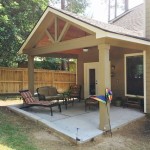Should a Patio Have a Slope in Accordance with Georgia Code?
The construction of a patio, seemingly a simple home improvement project, involves several considerations that extend beyond aesthetics. In Georgia, adhering to building codes is paramount to ensure safety, durability, and compliance with local regulations. One critical aspect of patio design is whether or not it should incorporate a slope. The answer isn't simply yes or no; it's nuanced and depends on various factors, including the type of patio material, the surrounding landscape, and the applicable sections of the Georgia State Minimum Standard Codes. This article aims to provide a comprehensive overview of the requirements and best practices surrounding patio slopes in Georgia, referencing relevant sections of the code and outlining the reasons behind these recommendations.
The primary reason for incorporating a slope into a patio design is to facilitate proper drainage. Without adequate drainage, water can accumulate on the patio surface, leading to several potential problems. These include the risk of water damage to adjacent structures, the growth of mold and mildew, the deterioration of patio materials, and the creation of hazardous walking surfaces. Building codes generally address drainage requirements to mitigate these risks and ensure the long-term integrity of the structure.
While the Georgia State Minimum Standard Codes do not explicitly dictate slope angles solely for patios, the underlying principles of drainage and water management are consistently emphasized throughout various sections. These principles are generally applicable to all exterior surfaces designed to be exposed to the elements. Therefore, interpreting these core principles within the context of patio construction is crucial for compliance.
Understanding the Principles of Drainage in Georgia Building Codes
Although a specific section dedicated solely to patio slope requirements may not exist, the Georgia code's overarching focus on proper drainage provides ample guidance. The International Building Code (IBC), which serves as a foundation for many aspects of Georgia's building regulations, addresses stormwater management and surface water drainage. The code emphasizes the importance of directing water away from buildings to prevent structural damage. This principle directly applies to patios, as they are often situated adjacent to a building's foundation.
Sections related to site grading and drainage are particularly relevant. Site grading refers to the manipulation of the ground's surface to control water flow. The code requires that the ground around a building be graded to slope away from the foundation. This prevents water from pooling near the foundation and potentially seeping into the basement or crawl space. While a patio isn't technically "ground," it is a constructed surface that rests upon the ground and directly impacts the flow of water around a building. Therefore, the principles of site grading should be considered when designing a patio.
Furthermore, regulations concerning impermeable surfaces can indirectly affect patio design. Impermeable surfaces, such as concrete or pavers set in mortar, do not allow water to penetrate into the ground. This means that all rainwater falling on these surfaces must be directed elsewhere. Proper drainage is essential to prevent water from accumulating on the patio or flowing towards the building. Incorporating a slope is a common and effective way to manage surface water runoff from impermeable patio surfaces.
The Georgia code also addresses the design and installation of drainage systems. While not specifically targeted at patios, these regulations outline best practices for managing stormwater runoff. These practices can be adapted to the specific needs of a patio, ensuring that water is effectively channeled away from the structure. For example, a patio might be sloped towards a drain that connects to an underground drainage system, preventing water from accumulating on the surface.
Moreover, local municipalities within Georgia may have their own specific ordinances regarding drainage and stormwater management. These local regulations can be stricter than the state code and may include explicit requirements for patio slopes. Consulting with the local building department is essential to ensure compliance with all applicable regulations.
Recommended Slope for Patios in Georgia
While the Georgia code might not specify a precise angle for patio slopes, industry best practices generally recommend a minimum slope of 1/4 inch per foot. This means that for every foot of patio surface, the elevation should drop by 1/4 inch. This slope provides sufficient drainage to prevent water from pooling, even during heavy rainstorms. A steeper slope might be necessary in areas with particularly high rainfall or where the patio surface is prone to collecting debris. However, excessively steep slopes can create tripping hazards and make it difficult to place outdoor furniture. Careful consideration must be given to the balance between adequate drainage and user safety.
The direction of the slope is also crucial. Ideally, the patio should slope away from the house to prevent water from flowing towards the foundation. If this isn't possible due to the existing landscape or other constraints, alternative drainage solutions, such as installing a French drain or a surface drain, may be necessary. These drainage systems can collect water and channel it away from the patio and the building.
The type of patio material also influences the required slope. For example, patios made of permeable pavers, which allow water to seep into the ground, might require a lesser slope compared to patios made of impermeable concrete. The permeability of the material will impact the amount of surface runoff that needs to be managed.
Regardless of the chosen slope, it is essential to ensure that the patio surface is smooth and even. Uneven surfaces can create puddles of water, even with a properly designed slope. Proper installation techniques, such as using a screed to level the base material, are crucial for achieving a smooth and even patio surface.
Consequences of Failing to Implement Proper Drainage
Ignoring the principles of drainage when constructing a patio can have significant consequences. As previously mentioned, water accumulation can lead to structural damage, mold and mildew growth, and hazardous walking surfaces. In addition, improper drainage can violate local building codes, resulting in fines or the requirement to re-construct the patio.
Water damage to the building's foundation is a serious concern. When water pools near the foundation, it can seep into cracks and crevices, leading to structural weakening and costly repairs. In colder climates, freeze-thaw cycles can exacerbate this damage as water expands when it freezes, further stressing the foundation.
Mold and mildew growth is another common problem associated with improper drainage. These fungi thrive in damp environments and can cause health problems, particularly for individuals with allergies or respiratory issues. Mold and mildew can also damage patio materials, requiring costly repairs or replacement.
Hazardous walking surfaces are a significant safety concern. Puddles of water can create slippery conditions, increasing the risk of falls. In colder climates, ice formation on the patio surface can create an even greater hazard. Proper drainage helps to prevent these dangerous conditions, ensuring the safety of users.
Moreover, failing to comply with building codes can have legal and financial ramifications. Local building inspectors have the authority to issue fines for code violations and can require property owners to correct any deficiencies. In some cases, this may involve completely re-constructing the patio to comply with drainage requirements. Obtaining the necessary permits and adhering to building codes from the outset can prevent these costly and time-consuming problems.
In summary, while a specific section of the Georgia State Minimum Standard Codes might not explicitly dictate patio slope angles, the underlying principles of drainage and water management are integral to ensuring compliance and preventing potential problems. Adhering to industry best practices, consulting with local building officials, and carefully considering the specific site conditions are essential for constructing a patio that is both aesthetically pleasing and functionally sound.
Questions On Sloping A Raised Patio Lawn Care Forum
Building Paver Patio On Slope Pics Lawn Care Forum

Chapter 4 Foundations Georgia State Minimum Standard One And Two Family Dwelling Code 2024 Upcodes

Chapter 4 Foundations Georgia State Minimum Standard One And Two Family Dwelling Code 2024 Upcodes

Retaining Wall Options For Your Home Or Business Fayetteville Ga

Residential Railing Codes
Three Side Raised Paver Patio Help Lawn Care Forum

Yard Grading In Gainesville Ga Rooted Landscape Management

Chapter 5 Floors Georgia State Minimum Standard One And Two Family Dwelling Code 2024 Upcodes

Chapter 8 Roof Ceiling Construction Georgia State Minimum Standard One And Two Family Dwelling Code 2024 Upcodes
See Also








